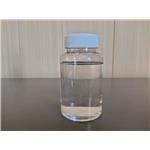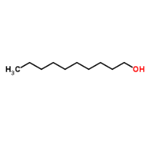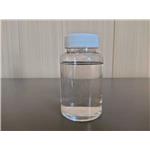1-Decanol
- CAS No.
- 112-30-1
- Chemical Name:
- 1-Decanol
- Synonyms
- 1-DECANOL;DECANOL;DECAN-1-OL;Antak;N-DECANOL;n-decyl;Exxal 10;ALCOHOL C10;n-Decan-1-ol;CAPRIC ALCOHOL
- CBNumber:
- CB1224014
- Molecular Formula:
- C10H22O
- Molecular Weight:
- 158.28
- MDL Number:
- MFCD00004747
- MOL File:
- 112-30-1.mol
- MSDS File:
- SDS
| Melting point | 5-7 °C (lit.) |
|---|---|
| Boiling point | 231 °C (lit.) |
| Density | 0.829 g/mL at 25 °C (lit.) |
| vapor density | 4.5 (vs air) |
| vapor pressure | 1 mm Hg ( 70 °C) |
| refractive index |
n |
| FEMA | 2365 | 1-DECANOL |
| Flash point | 180 °F |
| storage temp. | Store below +30°C. |
| solubility | ethanol: soluble60%, clear, colorless (1mL/3mL) |
| form | Liquid |
| pka | 15.21±0.10(Predicted) |
| color | Clear colorless to slightly yellow |
| Odor | Faint alcoholic. |
| explosive limit | 0.9-5.7%(V) |
| Odor Threshold | 0.00077ppm |
| Odor Type | fatty |
| Viscosity | 15.8mm2/s |
| Water Solubility | insoluble |
| Merck | 14,2855 |
| JECFA Number | 103 |
| BRN | 1735221 |
| Dielectric constant | 8.1(20℃) |
| InChIKey | MWKFXSUHUHTGQN-UHFFFAOYSA-N |
| LogP | 4.5 at 20℃ |
| Substances Added to Food (formerly EAFUS) | 1-DECANOL |
| FDA 21 CFR | 175.300; 176.170 |
| CAS DataBase Reference | 112-30-1(CAS DataBase Reference) |
| EWG's Food Scores | 1 |
| FDA UNII | 89V4LX791F |
| NIST Chemistry Reference | 1-Decanol(112-30-1) |
| EPA Substance Registry System | 1-Decanol (112-30-1) |
SAFETY
Risk and Safety Statements
| Symbol(GHS) |  GHS07 |
|||||||||
|---|---|---|---|---|---|---|---|---|---|---|
| Signal word | Warning | |||||||||
| Hazard statements | H319-H412 | |||||||||
| Precautionary statements | P264-P273-P280-P305+P351+P338-P337+P313-P501 | |||||||||
| Hazard Codes | Xn,N,Xi | |||||||||
| Risk Statements | 20-36/37/38-51/53-36/38-52/53-36 | |||||||||
| Safety Statements | 26-60-61-37/39-29-36 | |||||||||
| RIDADR | UN 3082 9/PG 3 | |||||||||
| WGK Germany | 1 | |||||||||
| RTECS | HE4375000 | |||||||||
| Autoignition Temperature | 550 °F | |||||||||
| TSCA | Yes | |||||||||
| HazardClass | 9 | |||||||||
| PackingGroup | III | |||||||||
| HS Code | 29051900 | |||||||||
| Toxicity | LD50 orally in Rabbit: 4720 mg/kg LD50 dermal Rabbit 3560 mg/kg | |||||||||
| NFPA 704 |
|
1-Decanol price More Price(42)
| Manufacturer | Product number | Product description | CAS number | Packaging | Price | Updated | Buy |
|---|---|---|---|---|---|---|---|
| Sigma-Aldrich | W236500 | 1-Decanol ≥98%, FCC, FG | 112-30-1 | 1kg | $76.5 | 2024-03-01 | Buy |
| Sigma-Aldrich | W236500 | 1-Decanol ≥98%, FCC, FG | 112-30-1 | 8kg | $270 | 2024-03-01 | Buy |
| Sigma-Aldrich | W236500 | 1-Decanol ≥98%, FCC, FG | 112-30-1 | 20kg | $417 | 2024-03-01 | Buy |
| Sigma-Aldrich | 8.03463 | 1-Decanol for synthesis | 112-30-1 | 100mL | $46.4 | 2024-03-01 | Buy |
| Sigma-Aldrich | 8.03463 | 1-Decanol for synthesis | 112-30-1 | 1L | $91.5 | 2024-03-01 | Buy |
1-Decanol Chemical Properties,Uses,Production
description
1-Decanol, also known as decyl alcohol or n-decyl alcohol, is a straight chain fatty alcohol with ten carbon atoms and the molecular formula CH3(CH2)9OH. It is a colorless viscous liquid that is insoluble in water. It is colorless and has a strong odor. It is a clear colorless liquid with a sweet fat-like odor. It has a flash point of 180°F. It is less dense than water and insoluble in water. Its vapors are heavier than air.
Applications
Decyl alcohol can be used for the production of plasticizers, lubricants, surfactants and solvents. It is also used to study the thermal properties of polymer-monolithic stationary phases. Furthermore, it can used to enhance homomeric glycine receptor function. In addition to this, it is used in daily flavor, food flavor and cosmetics. In addition, the 5HT2α receptors were inhibited by the presence of decyl alcohol. This action has many psychological repercussions on an individual. It can also be used as a plant growth regulator of tobacco.
Warning and Risk
Decyl alcohol causes a high irritability to skin and eyes, when splashed into the eyes it can cause permanent damage. Also inhalation and ingestion can be harmful, it can also function as a narcotic. It is also harmful in the environment.
Chemical Properties
1-Decanol is a clear colorless to slightly yellow liquid and has a floral odor resembling orange flowers and a slight, characteristic fatty taste. The threshold odor concentration in air for decyl alcohol (isomer not specified) was reportedly 6.3 ppb. soluble in glacial acetic acid, ethanol, benzene, petroleum ether, easily soluble in ether.
Occurrence
Reported in the essential oils of ambrette seeds and almond flowers; also in citrus oils, fermented beverages, apple juice, bilberry, American cranberry, papaya, raspberry, cheeses, milk, butter, beef, pork, beer, cognac, whiskey, red, white and sparkling wines, coriander seeds and cardamom.
Uses
1-Decanol is a long chain alcohol that has been seen to enhance homomeric glycine receptor function. In addition, the 5HT2α receptors were inhibited by the presence of 1-decanol. This action has many psychological repercussions on an individual. 1-Decanol is also used in the manufacture of plasticizers, synthetic lubricants, petroleum additives, herbicides, surface active agents, solvents. Has moderate antifoaming capacity.
Application
decyl alcohol can be used for any number of functions, including as an emollient, a foam-booster, a surfactant and a viscosity controller, as well to mask odor and as a fixative in perfumes. Decyl alcohol occurs naturally in sweet orange and ambrette seed. It is also derived commercially from liquid paraffin.
Definition
ChEBI: 1-Decanol is a fatty alcohol consisting of a hydroxy function at C-1 of an unbranched saturated chain of ten carbon atoms. It has a role as a metabolite and a protic solvent. It is a primary alcohol and a fatty alcohol.
Preparation
By sodium reduction or high-pressure catalytic hydrogenation of the esters of naturally occurring capric acid, or by oligomerization of ethylene using aluminium alkyl technology.
Production Methods
1-Decanol is prepared commercially by sodium reduction or by the high-pressure catalytic reduction of coconut oil, coconut fatty acids, or esters . It is also produced by the Ziegler process, which involves oxidation of trialkylaluminum compounds.
Aroma threshold values
Detection: 6 to 47 ppb
Synthesis Reference(s)
The Journal of Organic Chemistry, 38, p. 3223, 1973 DOI: 10.1021/jo00958a031
Synthetic Communications, 12, p. 287, 1982 DOI: 10.1080/00397918209409235
General Description
A clear colorless liquid with a sweet fat-like odor. Flash point 180°F. Less dense than water and insoluble in water. Vapors are heavier than air.
Air & Water Reactions
Insoluble in water.
Reactivity Profile
Decyl alcohol attacks plastics. REF [Handling Chemicals Safely, 1980. p. 236]. Acetyl bromide reacts violently with alcohols or water, [Merck 11th ed., 1989]. Mixtures of alcohols with concentrated sulfuric acid and strong hydrogen peroxide can cause explosions. Example: An explosion will occur if dimethylbenzylcarbinol is added to 90% hydrogen peroxide then acidified with concentrated sulfuric acid. Mixtures of ethyl alcohol with concentrated hydrogen peroxide form powerful explosives. Mixtures of hydrogen peroxide and 1-phenyl-2-methyl propyl alcohol tend to explode if acidified with 70% sulfuric acid, [Chem. Eng. News 45(43):73(1967); J, Org. Chem. 28:1893(1963)]. Alkyl hypochlorites are violently explosive. They are readily obtained by reacting hypochlorous acid and alcohols either in aqueous solution or mixed aqueous-carbon tetrachloride solutions. Chlorine plus alcohols would similarly yield alkyl hypochlorites. They decompose in the cold and explode on exposure to sunlight or heat. Tertiary hypochlorites are less unstable than secondary or primary hypochlorites, [NFPA 491 M, 1991]. Base-catalysed reactions of isocyanates with alcohols should be carried out in inert solvents. Such reactions in the absence of solvents often occur with explosive violence, [Wischmeyer(1969)].
Health Hazard
Direct contact can produce eye irritation; low general toxicity.
Fire Hazard
HIGHLY FLAMMABLE: Will be easily ignited by heat, sparks or flames. Vapors may form explosive mixtures with air. Vapors may travel to source of ignition and flash back. Most vapors are heavier than air. They will spread along ground and collect in low or confined areas (sewers, basements, tanks). Vapor explosion hazard indoors, outdoors or in sewers. Runoff to sewer may create fire or explosion hazard. Containers may explode when heated. Many liquids are lighter than water.
Chemical Reactivity
Reactivity with Water No reaction; Reactivity with Common Materials: No reaction; Stability During Transport: Stable; Neutralizing Agents for Acids and Caustics: Not pertinent; Polymerization: Not pertinent; Inhibitor of Polymerization: Not pertinent.
Safety Profile
Moderately toxic by skin contact. Wdly toxic by ingestion and inhalation. A severe human skin and eye irritant. Experimental reproductive effects. Questionable carcinogen with experimental tumorigenic data. Combustible when exposed to heat or flame; can react with oxidzing materials. To fight fire, use foam, CO2, dry chemical. When heated to decomposition it emits acrid smoke and irritating fumes. See also ALCOHOLS.
Synthesis
Synthetically prepared from coconut oil derivatives; by reduction of some capric esters, such as methyl caprate.
Carcinogenicity
1-Decanol showed weak to moderate tumor-promoting activity when applied three times a week for 60 weeks to the skin of female Swiss mice that previously received an initiating dose of dimethylbenz[ a]anthracene .
Metabolism
See alcohol C-8.
Purification Methods
Fractionally distil n-decanol in an all-glass unit at 10mm pressure (b 110o), then fractionally crystallise by partial freezing. Also purify by preparative GLC, and by passage through alumina before use. [Beilstein 1 IV 1815.]
1-Decanol Preparation Products And Raw materials
Raw materials
1of3
Preparation Products
1of3
| Supplier | Tel | Country | ProdList | Advantage | |
|---|---|---|---|---|---|
| Dayang Chem (Hangzhou) Co.,Ltd. | 571-88938639 +8617705817739 | info@dycnchem.com | CHINA | 52867 | 58 |
| Hebei Mojin Biotechnology Co., Ltd | +8613288715578 | sales@hbmojin.com | China | 12456 | 58 |
| Hebei Saisier Technology Co., LTD | +86-18400010335 +86-13102810335 | admin@hbsaisier.cn | China | 772 | 58 |
| Henan Tianfu Chemical Co.,Ltd. | +86-0371-55170693 +86-19937530512 | info@tianfuchem.com | China | 21691 | 55 |
| Shanxi Naipu Import and Export Co.,Ltd | +86-13734021967 +8613734021967 | kaia@neputrading.com | China | 1011 | 58 |
| career henan chemical co | +86-0371-86658258 | sales@coreychem.com | China | 29914 | 58 |
| SHANDONG ZHI SHANG CHEMICAL CO.LTD | +86 18953170293 | sales@sdzschem.com | China | 2931 | 58 |
| Jinan Finer Chemical Co., Ltd | +86-531-88989536 +86-15508631887 | sales@finerchem.com | China | 2967 | 58 |
| Hebei Guanlang Biotechnology Co., Ltd. | +86-19930503282 | alice@crovellbio.com | China | 8823 | 58 |
| Hubei xin bonus chemical co. LTD | 86-13657291602 | linda@hubeijusheng.com | CHINA | 22968 | 58 |
View Lastest Price from 1-Decanol manufacturers
| Image | Update time | Product | Price | Min. Order | Purity | Supply Ability | Manufacturer | |
|---|---|---|---|---|---|---|---|---|
 |
2024-04-19 | 1-Decanol
112-30-1
|
US $6.00 / KG | 1KG | More than 99% | 2000KG/MONTH | Hebei Saisier Technology Co., LTD | |
 |
2024-03-28 | Decyl alcohol
112-30-1
|
US $0.00 / KG | 25KG | Inquiry | Inquiry | PNP Biotech Co. Ltd | |
 |
2023-12-25 | 1-Decanol
112-30-1
|
US $0.00 / kg | 1kg | 99% | 1000000 | Hebei Jingbo New Material Technology Co., Ltd |
-

- 1-Decanol
112-30-1
- US $6.00 / KG
- More than 99%
- Hebei Saisier Technology Co., LTD
-

- Decyl alcohol
112-30-1
- US $0.00 / KG
- Inquiry
- PNP Biotech Co. Ltd
-

- 1-Decanol
112-30-1
- US $0.00 / kg
- 99%
- Hebei Jingbo New Material Technology Co., Ltd







